Label-Free Electrochemical Cell-Based Biosensor for Toxicity Assay of Water-Soluble Form of Phosphatidylcholine
Abstract
1. Introduction
2. Materials and Methods
2.1. Materials
2.2. Cell Lines
2.3. Study of Cytotoxicity of Water-Soluble Form of Phosphatidylcholine (wPC) by MTT Test In Vitro
2.4. Electrochemical Study of wPC Influence on Cell Lines
2.5. Statistical Analysis
3. Results
3.1. Cytotoxicity of Water-Soluble Form of Phosphatidylcholine wPC by MTT Test
3.2. Electrochemical Analysis of Cytotoxicity of Water-Soluble Form of Phosphatidylcholine (wPC)
3.3. Electrochemical Analysis of Water-Soluble Form of Phosphatidylcholine (wPC) and Doxorubicin on Cells
4. Discussion
5. Conclusions
Author Contributions
Funding
Institutional Review Board Statement
Informed Consent Statement
Data Availability Statement
Conflicts of Interest
References
- Popovich, I.G.; Anisimov, V.N. Geroprotectors and carcinogenesis. Rev. Clin. Pharmacol. Ther. 2004, 3, 61–69. [Google Scholar]
- Moskalev, A.; Guvatova, Z.; Lopes, I.A.; Beckett, C.W.; Kennedy, B.K.; De Magalhaes, J.P.; Makarov, A.A. Targeting aging mechanisms: Pharmacological perspectives. Trends Endocrinol. Metab. TEM 2022, 33, 266–280. [Google Scholar] [CrossRef]
- Moqri, M.; Herzog, C.; Poganik, J.R.; Biomarkers of Aging Consortium; Justice, J.; Belsky, D.W.; Higgins-Chen, A.; Moskalev, A.; Fuellen, G.; Cohen, A.A.; et al. Biomarkers of aging for the identification and evaluation of longevity interventions. Cell 2023, 186, 3758–3775. [Google Scholar] [CrossRef]
- Anisimov, V.N. Life span extension and cancer risk: Myths and reality. Exp. Gerontol. 2001, 36, 1101–1136. [Google Scholar] [CrossRef]
- Pozzo, L.D.; Xu, Z.; Lin, S.; Wang, J.; Wang, Y.; Enechojo, O.S.; Abankwah, J.K.; Peng, Y.; Chu, X.; Zhou, H.; et al. Role of epigenetics in the regulation of skin aging and geroprotective intervention: A new sight. Biomed. Pharmacother. 2024, 174, 116592. [Google Scholar] [CrossRef] [PubMed]
- Bea, A.M.; González-Guerrero, A.; Cenarro, A.; Lamiquiz-Moneo, I.; Climent, E.; Jarauta, E.; Gracia-Rubio, I.; Benaiges, D.; Laclaustra, M.; Tejedor, T.; et al. Association of HDL cholesterol with all-cause and cardiovascular mortality in primary hypercholesterolemia. Atherosclerosis 2025, 400, 118617. [Google Scholar] [CrossRef]
- Morvaridzadeh, M.; Zoubdane, N.; Heshmati, J.; Alami, M.; Berrougui, H.; Khalil, A. High-Density Lipoprotein Metabolism and Function in Cardiovascular Diseases: What about Aging and Diet Effects? Nutrients 2024, 16, 653. [Google Scholar] [CrossRef]
- Pietri, P.; Stefanadis, C. Cardiovascular Aging and Longevity: JACC State-of-the-Art Review. J. Am. Coll. Cardiol. 2021, 77, 189–204. [Google Scholar] [CrossRef] [PubMed]
- Pinto, C.; Ninfole, E.; Gaggiano, L.; Benedetti, A.; Marzioni, M.; Maroni, L. Aging and the Biological Response to Liver Injury. Semin. Liver Dis. 2019, 40, 225–232. [Google Scholar]
- Zhang, M.; Serna-Salas, S.; Damba, T.; Borghesan, M.; Demaria, M.; Moshage, H. Hepatic stellate cell senescence in liver fibrosis: Characteristics, mechanisms and perspectives. Mech. Ageing Dev. 2021, 199, 111572. [Google Scholar] [CrossRef]
- Yao, J.; Li, Y.; Wang, H. The Roles of Myeloid Cells in Aging-related Liver Diseases. Int. J. Biol. Sci. 2023, 19, 1564–1578. [Google Scholar] [CrossRef] [PubMed]
- van der Veen, J.N.; Kennelly, J.P.; Wan, S.; Vance, J.E.; Vance, D.E.; Jacobs, R.L. The critical role of phosphatidylcholine and phosphatidylethanolamine metabolism in health and disease. Biochim. Biophys. Acta Biomembr. 2017, 1859, 1558–1572. [Google Scholar] [CrossRef]
- Ipatova, O.M.; Prozorovskaia, N.N.; Torkhovskaia, T.I.; Baranova, V.S.; Guseva, D.A. Biological effects of the soybean phospholipids. Biomed. Khim. 2004, 50, 436–450. [Google Scholar] [PubMed]
- Medvedeva, N.V.; Prosorovskiy, V.N.; Ignatov, D.V.; Druzilovskaya, O.S.; Kudinov, V.A.; Kasatkina, E.O.; Tikhonova, E.G.; Ipatova, O.M. Pharmacological agents and transport nanosystems based on plant phospholipids. Biomed. Khim. 2015, 61, 219–230. [Google Scholar] [CrossRef]
- Davis, S.E.; Zabotka, L.; Desai, R.J.; Wang, S.V.; Maro, J.C.; Coughlin, K.; Hernández-Muñoz, J.J.; Stojanovic, D.; Shah, N.H.; Smith, J.C. Use of Electronic Health Record Data for Drug Safety Signal Identification: A Scoping Review. Drug Saf. 2023, 46, 725–742. [Google Scholar] [CrossRef]
- Kim, H.S.; Wainer, I.W. Simultaneous analysis of liposomal doxorubicin and doxorubicin using capillary electrophoresis and laser induced fluorescence. J. Pharm. Biomed. Anal. 2010, 52, 372–376. [Google Scholar] [CrossRef] [PubMed]
- Qi, P.; Li, P.; Qiao, L.; Xue, H.; Ma, Y.; Wei, S.; Yang, X.; Zhang, H.; Zhang, Y.; Wang, Y.; et al. Simultaneous quantification of pirarubicin, doxorubicin, cyclophosphamide, and vincristine in human plasma of patients with non-Hodgkin’s lymphoma by LC-MS/MS method. J. Chromatogr. B Analyt. Technol. Biomed. Life Sci. 2023, 1224, 123754. [Google Scholar] [CrossRef]
- Watanabe, A.; Murayama, S.; Karasawa, K.; Yamamoto, E.; Morikawa, S.; Takita, R.; Murata, S.; Kato, M. A Simple and Easy Method of Monitoring Doxorubicin Release from a Liposomal Drug Formulation in the Serum Using Fluorescence Spectroscopy. Chem. Pharm. Bull. 2019, 67, 367–371. [Google Scholar] [CrossRef]
- Rus, I.; Tertiș, M.; Barbălată, C.; Porfire, A.; Tomuță, I.; Săndulescu, R.; Cristea, C. An Electrochemical Strategy for the Simultaneous Detection of Doxorubicin and Simvastatin for Their Potential Use in the Treatment of Cancer. Biosensors 2021, 11, 15. [Google Scholar] [CrossRef]
- Cetinkaya, A.; Kaya, S.I.; Ozcelikay, G.; Budak, F.; Ozkan, S.A. Carbon Nanomaterials-Based Novel Hybrid Platforms for Electrochemical Sensor Applications in Drug Analysis. Crit. Rev. Anal. Chem. 2024, 54, 1227–1242. [Google Scholar] [CrossRef]
- Lima, H.R.S.; da Silva, J.S.; de Oliveira Farias, E.A.; Teixeira, P.R.S.; Eiras, C.; Nunes, L.C.C. Electrochemical sensors and biosensors for the analysis of antineoplastic drugs. Biosens. Bioelectron. 2018, 108, 27–37. [Google Scholar] [CrossRef]
- Wang, J.; Wu, C.; Hu, N.; Zhou, J.; Du, L.; Wang, P. Microfabricated electrochemical cell-based biosensors for analysis of living cells in vitro. Biosensors 2012, 2, 127–170. [Google Scholar] [CrossRef]
- Wei, X.; Reddy, V.S.; Gao, S.; Zhai, X.; Li, Z.; Shi, J.; Niu, L.; Zhang, D.; Ramakrishna, S.; Zou, X. Recent advances in electrochemical cell-based biosensors for food analysis: Strategies for sensor construction. Biosens. Bioelectron. 2024, 248, 115947. [Google Scholar] [CrossRef]
- Kun, C.; Jinhua, C.; Manli, G.; Zhenfeng, L.; Shouzhuo, Y. Electrochemical Behavior of MCF-7 Cells on Carbon Nanotube Modified Electrode and Application in Evaluating the Effect of 5-Fluorouracil. Electroanalysis 2006, 18, 1179–1185. [Google Scholar]
- Kim, J.; Campbell, A.S.; de Ávila, B.E.; Wang, J. Wearable biosensors for healthcare monitoring. Nat. Biotechnol. 2019, 37, 389–406. [Google Scholar] [CrossRef] [PubMed]
- Chandra, P. Personalized biosensors for point-of-care diagnostics: From bench to bedside applications. Nanotheranostics 2023, 7, 210–215. [Google Scholar] [CrossRef]
- Gupta, N.; Renugopalakrishnan, V.; Liepmann, D.; Paulmurugan, R.; Malhotra, B.D. Cell-based biosensors: Recent trends, challenges and future perspectives. Biosens. Bioelectron. 2019, 141, 111435. [Google Scholar] [CrossRef] [PubMed]
- Shumyantseva, V.V.; Bulko, T.V.; Chistov, A.A.; Kolesanova, E.F.; Agafonova, L.E. Electroanalytical characteristics of an antiviral drug favipiravir and analysis of its interaction with DNA. Pharmaceutics 2024, 16, 503. [Google Scholar] [CrossRef]
- Kostryukova, L.V.; Serdyukova, A.S.; Pronina, V.V.; Shumyantseva, V.V.; Tereshkina, Y.A. An Electrochemical Biosensor Analysis of the Interaction of a Two-Vector Phospholipid Composition of Doxorubicin with dsDNA and Breast Cancer Cell Models In Vitro. Pharmaceutics 2024, 16, 1412. [Google Scholar] [CrossRef]
- Koroleva, P.I.; Bulko, T.V.; Kuzikov, A.V.; Gilep, A.A.; Romashova, Y.u.A.; Tichonova, E.G.; Kostryukova, L.V.; Archakov, A.I.; Shumyantseva, V.V. Role assessment of water-soluble pharmaceutical form of phosphatidylcholine on the catalytic activity of cytochrome P450 2C9 and 2D6. Int. J. Mol. Sci. 2025, 26, 4. [Google Scholar] [CrossRef]
- Sanz, C.G.; Diculescu, V.C. Electrochemical Protein-based Bioanalytical Devices for Drug Analysis. Curr. Top. Med. Chem. 2023, 23, 1448–1463. [Google Scholar] [CrossRef] [PubMed]
- Javalkar, V.; Nn Sh Khosla, A.; Khosla, A.; Krishna, R.H.; Chjeelenahalii, M. Review on Biosensors: Fundamentals, Classifications, Characteristics, Simulations, and Potential Applications. ECS Trans. 2022, 107, 13005–13029. [Google Scholar]
- Zubareva, M.; Kudinov, V.; Malyshev, P.; Rozhkova, T.; Markin, S.; Kukharchuk, V. Usage of a new pharmacological agent of ultra-small phospholipid nanoparticles (micelles) in the treatment of combined hyperlipidemia. Eur. Heart. J. 2020, 41, 3007. [Google Scholar] [CrossRef]
- Tikhonova, E.G.; Sanzhakov, M.A.; Tereshkina, Y.A.; Kostryukova, L.V.; Khudoklinova, Y.Y.; Orlova, N.A.; Bobrova, D.V.; Ipatova, O.M. Drug Transport System Based on Phospholipid Nanoparticles: Production Technology and Characteristics. Pharmaceutics 2022, 14, 2522. [Google Scholar] [CrossRef]
- Archakov, A.; Kukharchuk, V.; Lisitsa, A.; Ponomarenko, E.; Romashova Yu Pleshakova, T.; Yarovaya, E.; Kutsenko, V.; Guseva, M.; Beregovykh, V.; Ipatova, O.; et al. Ultra-small phospholipid nanoparticles in the treatment of combined hyperlipidemia: A randomized placebo-controlled clinical trial. Res. Pharm. Sci. (RPS) 2024, 19, 656–668. [Google Scholar] [CrossRef] [PubMed]
- Wei, X.; Liu, C.; Li, Z.; Sun, Q.; Zhang, X.; Li, Y.; Zhang, W.; Shi, J.; Zhai, X.; Zhang, D.; et al. Fabrication of a label-free electrochemical cell-based biosensor for toxicity assessment of thiram. Chemosphere 2022, 307, 135960. [Google Scholar] [CrossRef]
- Najahi-Missaoui, W.; Arnold, R.D.; Cummings, B.S. Safe Nanoparticles: Are We There Yet? Int. J. Mol. Sci. 2020, 22, 385. [Google Scholar] [CrossRef]
- Wolfram, J.; Zhu, M.; Yang, Y.; Shen, J.; Gentile, E.; Paolino, D.; Fresta, M.; Nie, G.; Chen, C.; Shen, H.; et al. Safety of Nanoparticles in Medicine. Curr. Drug Targets 2015, 16, 1671–1681. [Google Scholar] [CrossRef]
- De Jong, W.H.; Borm, P.J. Drug delivery and nanoparticles:applications and hazards. Int. J. Nanomed. 2008, 3, 133–149. [Google Scholar] [CrossRef]
- Kciuk, M.; Gielecińska, A.; Mujwar, S.; Kołat, D.; Kałuzińska-Kołat, Ż.; Celik, I.; Kontek, R. Doxorubicin-An Agent with Multiple Mechanisms of Anticancer Activity. Cells 2023, 12, 659. [Google Scholar] [CrossRef]
- Tomankova, K.; Polakova, K.; Pizova, K.; Binder, S.; Havrdova, M.; Kolarova, M.; Kriegova, E.; Zapletalova, J.; Malina, L.; Horakova, J.; et al. In vitro cytotoxicity analysis of doxorubicin-loaded/superparamagnetic iron oxide colloidal nanoassemblies on MCF7 and NIH3T3 cell lines. Int. J. Nanomed. 2015, 10, 949–961. [Google Scholar] [CrossRef]
- Husain, A.; Meenakshi, D.U.; Ahmad, A.; Shrivastava, N.; Khan, S.A. A Review on Alternative Methods to Experimental Animals in Biological Testing: Recent Advancement and Current Strategies. J. Pharm. Bioallied Sci. 2023, 15, 165–171. [Google Scholar] [CrossRef] [PubMed]
- Aslantürk, Ö.S. In Vitro Cytotoxicity and Cell Viability Assays: Principles, Advantages, and Disadvantages. In Genotoxicity—A Predictable Risk to Our Actual World; Larramendy, M.L., Soloneski, S., Eds.; IntechOpen: London, UK, 2018; Volume 1, pp. 1–17. [Google Scholar]
- Koo, K.M.; Kim, C.D.; Ju, F.N.; Kim, H.; Kim, C.H.; Kim, T.H. Recent Advances in Electrochemical Biosensors for Monitoring Animal Cell Function and Viability. Biosensors 2022, 12, 1162. [Google Scholar] [CrossRef] [PubMed]
- Ramotowska, S.; Ciesielska, A.; Makowski, M. What Can Electrochemical Methods Offer in Determining DNA–Drug Interactions? Molecules 2021, 26, 3478. [Google Scholar] [CrossRef]
- Cui, Z.; Luan, X.; Jiang, H.; Li, Q.; Xu, G.; Sun, C.; Zheng, L.; Song, Y.; Davison, P.A.; Huang, W.E. Application of a bacterial whole cell biosensor for the rapid detection of cytotoxicity in heavy metal contaminated seawater. Chemosphere 2018, 200, 322–329. [Google Scholar] [CrossRef]
- Jiang, D.; Sheng, K.; Gui, G.; Jiang, H.; Liu, X.; Wang, L. A novel smartphone-based electrochemical cell sensor for evaluating the toxicity of heavy metal ions Cd2+, Hg2+, and Pb2+ in rice. Anal. Bioanal. Chem. 2021, 413, 4277–4287. [Google Scholar] [CrossRef] [PubMed]
- Li, J.; Song, J.; Bi, S.; Zhou, S.; Cui, J.; Liu, J.; Wu, D. Electrochemical estrogen screen method based on theelectrochemical behavior of MCF-7 cells. J. Hazard. Mater. 2016, 313, 238–243. [Google Scholar] [CrossRef]
- Shashaani, H.; Akbari, N.; Faramarzpour, M.; Parizi, M.S.; Vanaei, S.; Khayamian, M.A.; Abdolahad, M. Cyclic voltammetric biosensing of cellular ionic secretion based on silicon nanowires to detect the effect of paclitaxel on breast normal and cancer cells. Microelectron. Eng. 2021, 239–240, 111512. [Google Scholar] [CrossRef]
- Li, J.; Lin, R.; Wang, Q.; Gao, G.; Cui, J.; Liu, J.; Wu, D. Two-signal electrochemical method for evaluation suppression and proliferation of MCF-7 cells based on intracellular purine. Anal. Biochem. 2014, 456, 1–5. [Google Scholar] [CrossRef]
- Alim, S.; Vejayan, J.; Yusoff, M.M.; Kafi, A.K.M. Recent uses of carbon nanotubes & gold nanoparticles in electrochemistry with application in biosensing: A review. Biosens. Bioelectron. 2018, 121, 125–136. [Google Scholar]
- Admasu, T.D.; Chaithanya Batchu, K.; Barardo, D.; Ng, L.F.; Lam, V.Y.M.; Xiao, L.; Cazenave-Gassiot, A.; Wenk, M.R.; Tolwinski, N.S.; Gruber, J. Drug Synergy Slows Aging and Improves Healthspan through IGF and SREBP Lipid Signaling. Dev. Cell 2018, 47, 67–79. [Google Scholar] [CrossRef] [PubMed]
- Bahri, M.; Shi, B.; Elaguech, M.A.; Djebbi, K.; Zhou, D.; Liang, L.; Tlili Ch Wang, D. Tungsten Disulfide Nanosheet-Based Field-Effect Transistor Biosensor for DNA Hybridization Detection. ACS Appl. Nano Mater. 2022, 5, 5035–5044. [Google Scholar] [CrossRef]
- Bahri, M.; Fredj, Z.; Qin, P.; Sawan, M. DNA-Coupled AuNPs@CuMOF for Sensitive Electrochemical Detection of Carcinoembryonic Antigen. ACS Appl. Nano Mater. 2024, 7, 11921–11930. [Google Scholar] [CrossRef]
- Tang, B.; Li, X.; Wang, Y.; Sjölander, A.; Johnell, K.; Thambisetty, M.; Ferrucci, L.; Reynolds, C.A.; Finkel, D.; Jylhävä, J.; et al. Longitudinal associations between use of antihypertensive, antidiabetic, and lipid-lowering medications and biological aging. Geroscience 2023, 45, 2065–2078. [Google Scholar] [CrossRef]
- Zeng, Q.; Gong, Y.; Zhu, N.; Shi, Y.; Zhang, C.; Qin, L. Lipids and lipid metabolism in cellular senescence: Emerging targets for age-related diseases. Ageing Res. Rev. 2024, 97, 102294. [Google Scholar] [CrossRef]
- Chin, C.F.; Galam, D.; Gao, L.; Tan, B.C.; Wong, B.H.; Chua, G.L.; Loke, R.Y.; Lim, Y.C.; Wenk, M.R.; Lim, M.S.; et al. Blood-derived lysophospholipid sustains hepatic phospholipids and fat storage necessary for hepatoprotection in overnutrition. J. Clin. Investig. 2023, 133, e171267. [Google Scholar] [CrossRef] [PubMed]
- Zhang, Y.; Li, Q.; Niu, Y.; Wei, K.; Wang, X.; Niu, B.; Zhang, L. Research progress on aging mechanism and drugs and the role of stem cells in anti-aging process. Exp. Gerontol. 2023, 179, 112248. [Google Scholar] [CrossRef]
- Moskalev, A.; Chernyagina, E.; Kudryavtseva, A.; Shaposhnikov, M. Geroprotectors: A Unified Concept and Screening Approaches. Aging Dis. 2017, 8, 354–363. [Google Scholar] [CrossRef]
- Prilepsky, A.Y.; Drozdov, A.S.; Bogatyrev, V.A.; Staroverov, S.A. Methods of Working with Cell Cultures and Determining the Toxicity of Nanomaterials; ITMO University: Saint Petersburg, Russia, 2019; 43p. [Google Scholar]
- Meikle, P.J.; Formosa, M.F.; Mellett, N.A.; Jayawardana, K.S.; Giles, C.; Bertovic, D.A.; Jennings, G.L.; Childs, W.; Reddy, M.; Carey, A.L.; et al. HDL Phospholipids, but Not Cholesterol Distinguish Acute Coronary Syndrome from Stable Coronary Artery Disease. J. Am. Heart. Assoc. 2019, 8, e011792. [Google Scholar] [CrossRef]
- Zhu, X.; Zheng, H.; Zhang, Z.; Ma, S.; Feng, Q.; Wang, J.; Wu, G.; Ng, H.Y. Cytotoxicity evaluation of organophosphorus flame retardants using electrochemical biosensors and elucidation of associated toxic mechanisms. Water Res. 2024, 265, 122262. [Google Scholar] [CrossRef]
- Sun, X.; Ji, J.; Jiang, D.; Li, X.; Zhang, Y.; Li, Z.; Wu, Y. Development of a novel electrochemical sensor using pheochromocytoma cells and its assessment of acrylamide cytotoxicity. Biosens. Bioelectron. 2023, 44, 122–126. [Google Scholar] [CrossRef] [PubMed]
- Damiatia, S.; Küpcüb, S.; Peacockd, M.; Eilenbergerb, C.; Zamzamia, M.; Qadrie, I.; Choudhrya, H.; Sleytrg, U.; Schusterb, B. Acoustic and hybrid 3D-printed electrochemical biosensors for the real-time immunodetection of liver cancer cells (HepG2). Biosens. Bioelectron. 2017, 94, 500–506. [Google Scholar] [CrossRef] [PubMed]
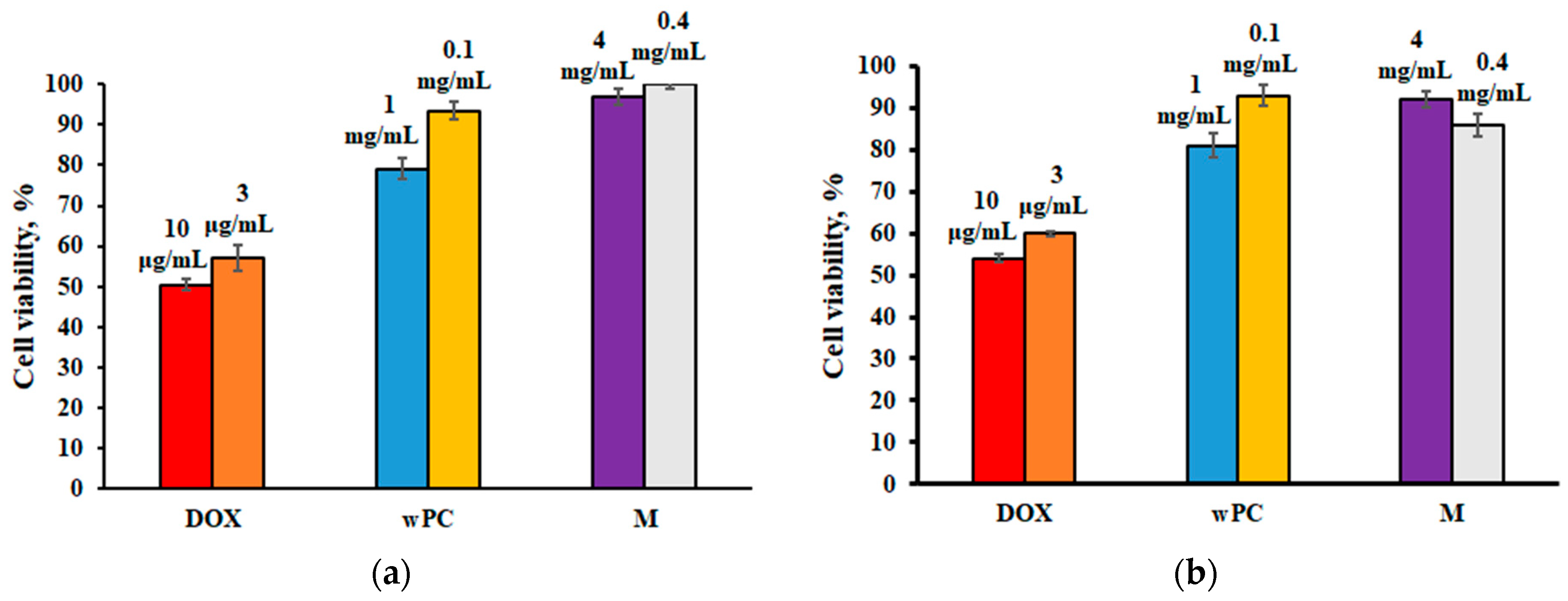
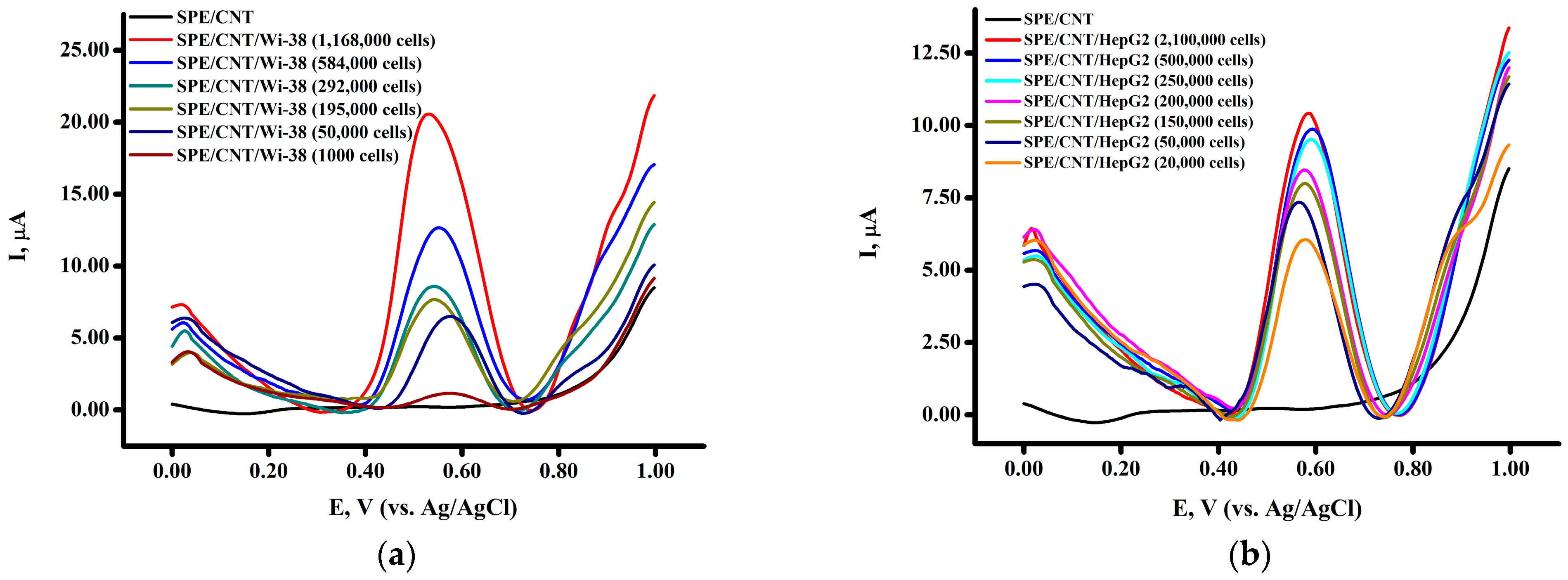
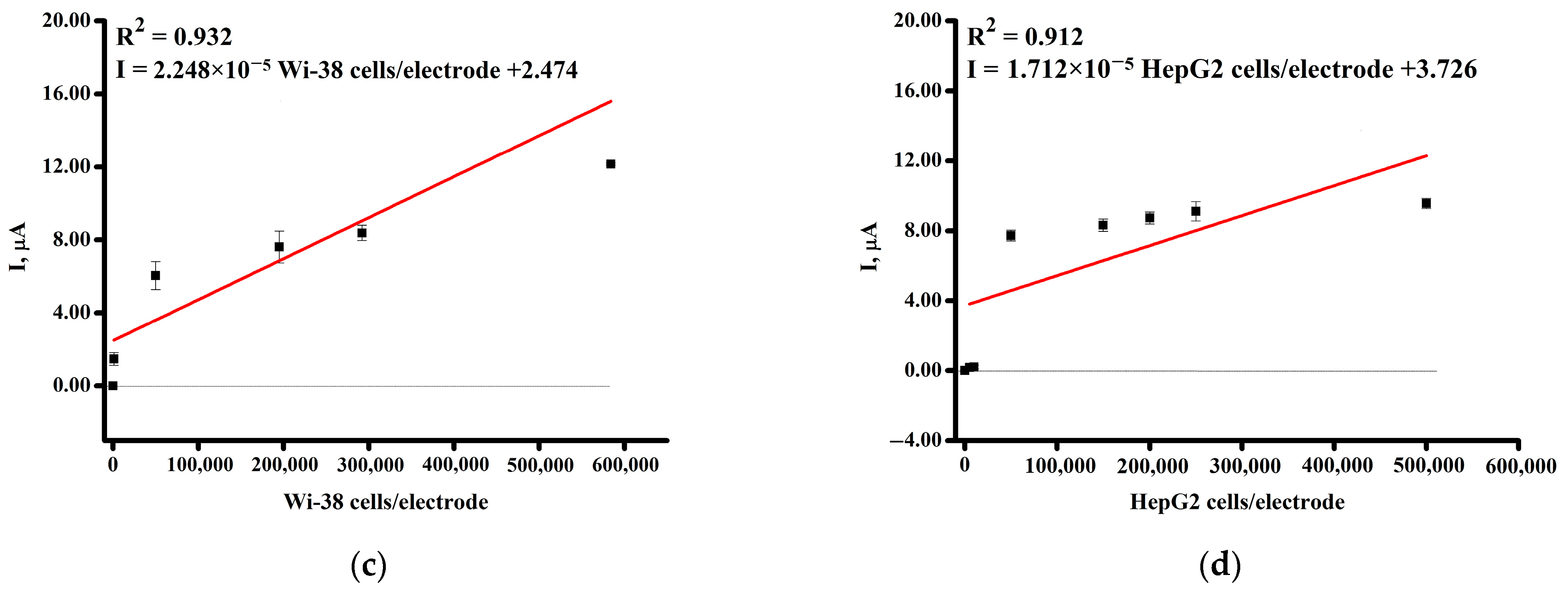
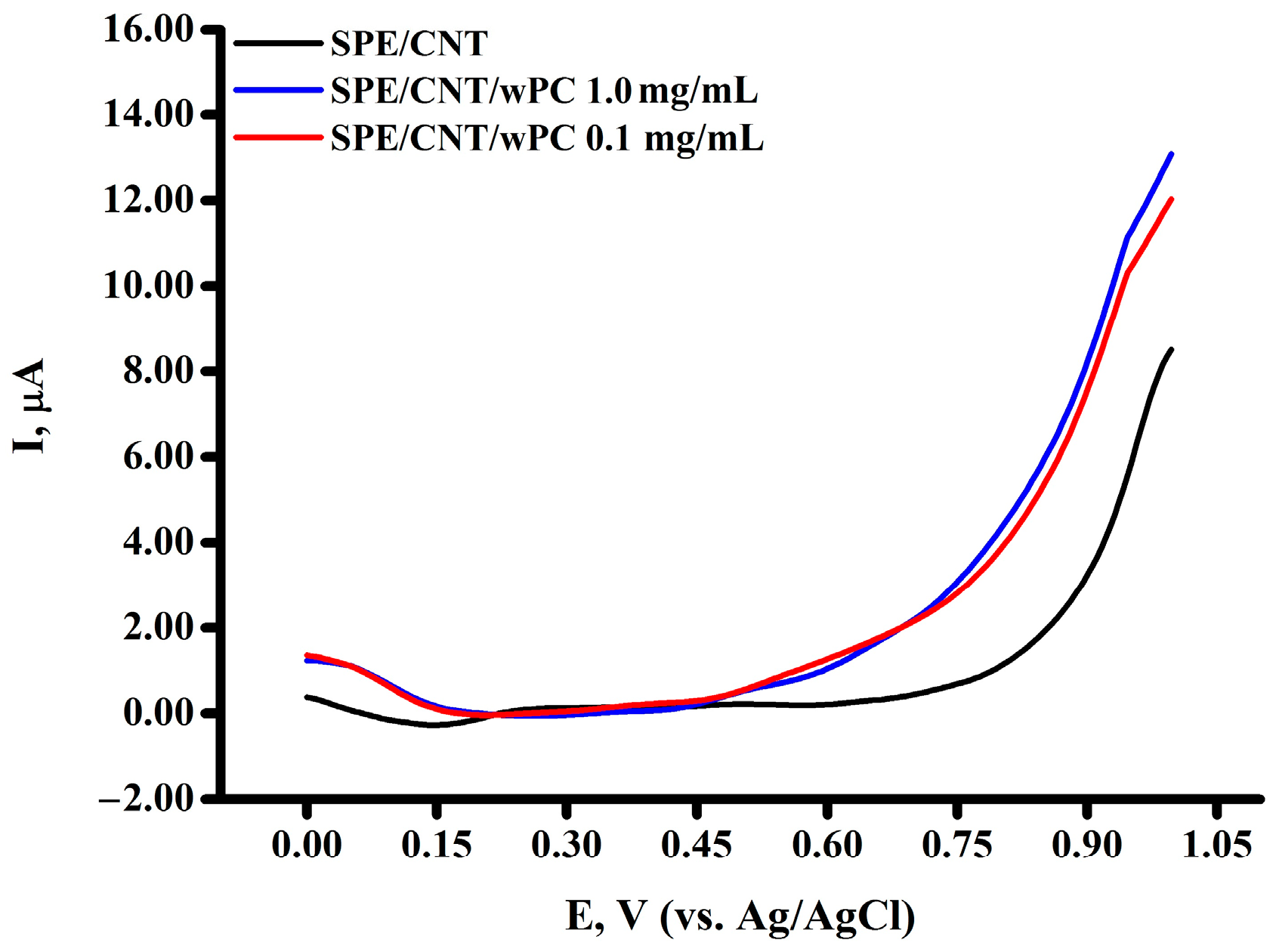
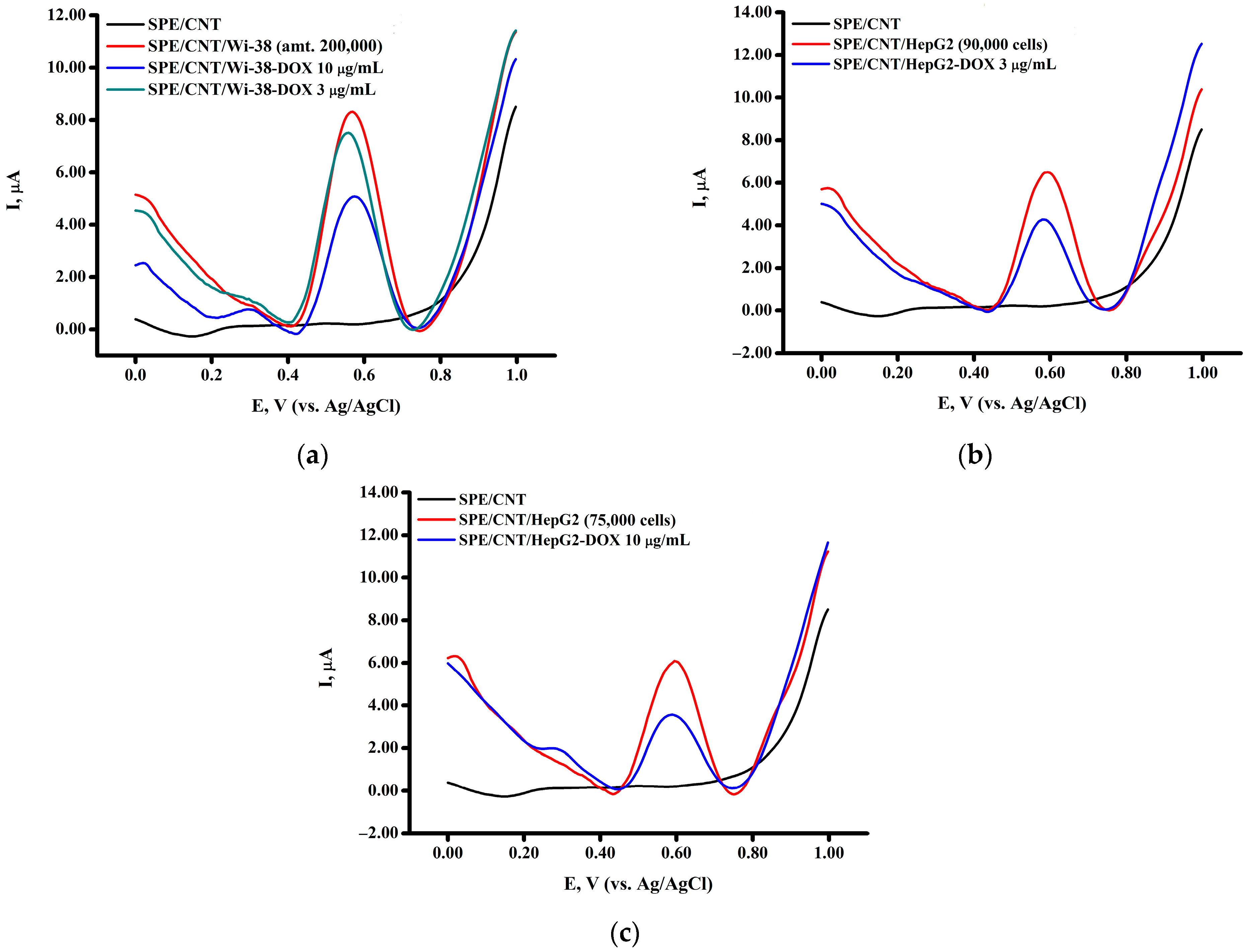


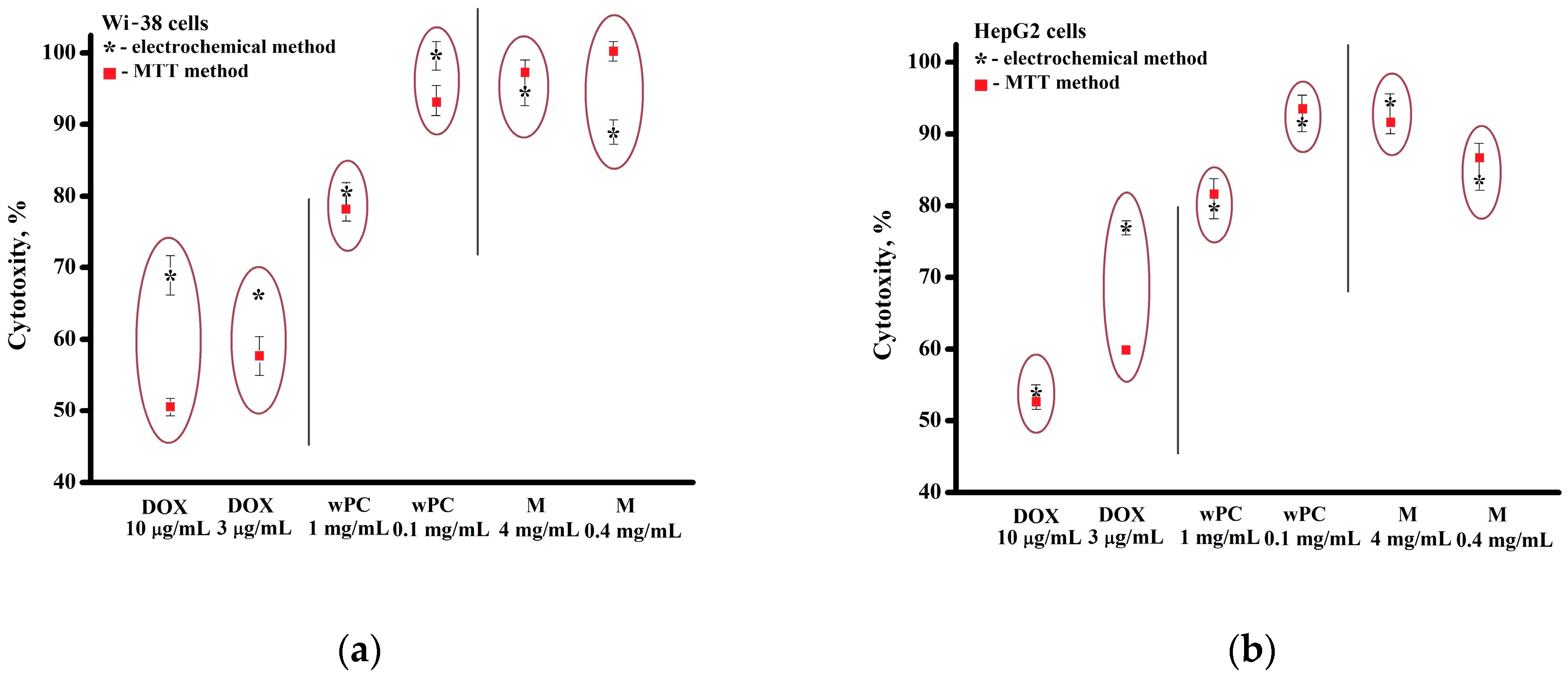
| Sample | Cell Viability (Electrochemical Analysis), % ± SD | Cell Viability (MTT Assay), % ± SD |
|---|---|---|
| Wi-38 Cell Line | ||
| DOX 10 µg/mL | 68.9 ± 2.73 | 50.5 ± 1.24 |
| DOX 3 µg/mL | 65.41 ± 0.47 | 57.13 ± 3.23 |
| wPC 1 mg/mL | 80.6 ± 0.92 | 79.13 ± 2.60 |
| wPC 0.1 mg/mL | 99.6 ± 2.04 | 93.34 ± 2.20 |
| Maltose 4 mg/mL | 94.8 ± 2.48 | 97.0 ± 2.04 |
| Maltose 0.4 mg/mL | 88.9 ± 1.77 | 100 ± 0.97 |
| HepG2 Cell Line | ||
| DOX 10 µg/mL | 53.2 ± 0.93 | 54.0 ± 1.04 |
| DOX 3 µg/mL | 77.7 ± 0.93 | 60.0 ± 0.53 |
| wPC 1 mg/mL | 79.7 ± 0.36 | 81.0 ± 2.8 |
| wPC 0.1 mg/mL | 91.5 ± 1.00 | 93.0 ± 2.4 |
| Maltose 4 mg/mL | 94.8 ± 0.18 | 92.0 ± 1.95 |
| Maltose 0.4 mg/mL | 83.2 ± 0.27 | 86.0 ± 2.7 |
Disclaimer/Publisher’s Note: The statements, opinions and data contained in all publications are solely those of the individual author(s) and contributor(s) and not of MDPI and/or the editor(s). MDPI and/or the editor(s) disclaim responsibility for any injury to people or property resulting from any ideas, methods, instructions or products referred to in the content. |
© 2025 by the authors. Licensee MDPI, Basel, Switzerland. This article is an open access article distributed under the terms and conditions of the Creative Commons Attribution (CC BY) license (https://creativecommons.org/licenses/by/4.0/).
Share and Cite
Pronina, V.V.; Kostryukova, L.V.; Ivanov, S.V.; Tichonova, E.G.; Archakov, A.I.; Shumyantseva, V.V. Label-Free Electrochemical Cell-Based Biosensor for Toxicity Assay of Water-Soluble Form of Phosphatidylcholine. Biomedicines 2025, 13, 996. https://doi.org/10.3390/biomedicines13040996
Pronina VV, Kostryukova LV, Ivanov SV, Tichonova EG, Archakov AI, Shumyantseva VV. Label-Free Electrochemical Cell-Based Biosensor for Toxicity Assay of Water-Soluble Form of Phosphatidylcholine. Biomedicines. 2025; 13(4):996. https://doi.org/10.3390/biomedicines13040996
Chicago/Turabian StylePronina, Veronica V., Lyubov V. Kostryukova, Sergey V. Ivanov, Elena G. Tichonova, Alexander I. Archakov, and Victoria V. Shumyantseva. 2025. "Label-Free Electrochemical Cell-Based Biosensor for Toxicity Assay of Water-Soluble Form of Phosphatidylcholine" Biomedicines 13, no. 4: 996. https://doi.org/10.3390/biomedicines13040996
APA StylePronina, V. V., Kostryukova, L. V., Ivanov, S. V., Tichonova, E. G., Archakov, A. I., & Shumyantseva, V. V. (2025). Label-Free Electrochemical Cell-Based Biosensor for Toxicity Assay of Water-Soluble Form of Phosphatidylcholine. Biomedicines, 13(4), 996. https://doi.org/10.3390/biomedicines13040996







